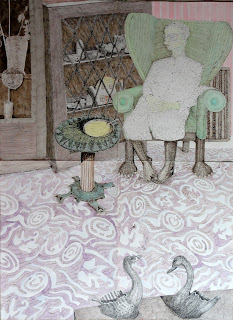
When my mother was dying I used to go down to my home town every weekend to see her and sit with her. I drew her several times and when she finally passed away I made images from the drawings as a way to come to terms with how I felt about her death. She was always surrounded by her 'tranculments', which had by then mainly been placed in glass fronted cabinets, but several, such as the swan vases or a toby jug, still adorned any spare surface, such as the top of the TV. I could find myself dizzy with the carpet pattern, often just looking for somewhere to rest my eyes, and when they rested on her, she seemed the most insubstantial thing in the room. I have a drawing of her where she literally dissolves into her chair and others where she becomes manic in her distress or lost in her bed. One drawing I made of her in bed, shows her dissolving into the pillow, whilst the bedspread becomes a repository of stories from her life. I drew all sorts of events that she had told me about, including the time when her sister Mary had trapped her foot in a rail line junction point, and how they were terrified a train would come. I tried to remember when she was happy and times when we were together, but there were many sad times too. Eventually the bedspread was covered with memories.
Maggie Hambling drew both her mother and her father as they were dying.
Hambling's drawings use a searching line that I feel attempts to give back life to the dead. Her own energy of looking is locked into these images forever, and when she has herself passed on, she will still exist in the frozen moments of her looking.
Occasionally Foundation students used to ask me if they could get to draw dead people and the only person I knew at the time that had a way in to do this was Brian Holmes. I remember that I drew his portrait at one time, as he used to live just around the corner from where I lived in Kirkstall, however where that drawing is now I haven't a clue and he is now long dead, a reminder that every portrait ever made is in fact a memento mori. Brian was at one point commissioned by the School of Medicine of the University of Leeds to paint a mural detailing the history of Leeds Medical School and that meant he had access to their facilities, including the dissection area.
During the many years that Christianity formed the dominant religion of the Western World, images of the dead or dying Christ were available for everyone to see. People were constantly therefore being reminded of how death was a central fact of life. In traditional Buddhist teachings, contemplating death is an integral part of meditation. Buddha states that death is “the greatest of all teachers”; it teaches us to be humble, destroys vanity and pride and crumbles all the barriers of caste, creed and race that divide humans, for all living beings are destined to die.
If I had to show one image that transcended the genre it would be the one below by Käthe Kollwitz. Kollwitz drew the workers that she met, particularly women who struggled to keep themselves alive under the most harsh conditions. In this image the woman you feel can see her own death in a not very far off future, a black ghost already sitting at her shoulder. But at the same time Kollwitz has found a deep humanity in this woman, she is a solid yet wonderfully delicate presence, on the one hand to be blown away by the trials of a hard life and yet on the other she is preserved, rock like, in all her dignity within Kollwitz's drawing. She is always in that moment that she appeared to Kollwitz, time past, present and future unravel and we are forever in the now of her being.















No comments:
Post a Comment